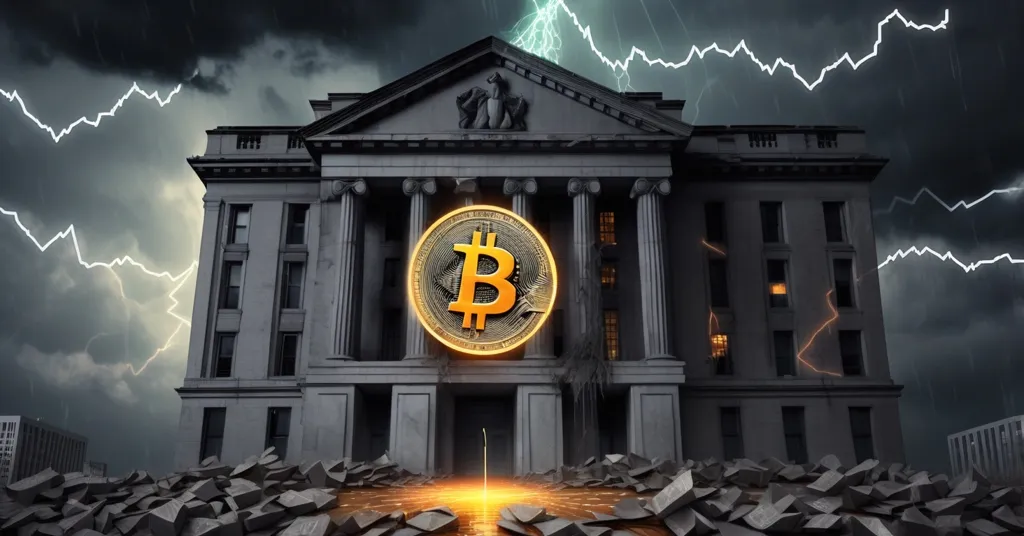RBNZ Overhauls Policy Amid Economic Slump: Could Bitcoin Be the Answer?

RBNZ Revamps Monetary Toolkit Amid Inflation Struggles and Economic Downturn
New Zealand’s central bank is scrambling to rebuild its playbook after the COVID-19 pandemic exposed glaring holes in its approach to inflation and economic stability. The Reserve Bank of New Zealand (RBNZ) is rolling out a revamped set of tools to face future shocks, but with a brutal economic slump and whispers of political meddling, the stakes couldn’t be higher. As trust in centralized systems wavers, could Bitcoin and decentralized finance (DeFi) offer a lifeline?
- RBNZ overhauls policy tools, focusing on supply shocks and real-time data monitoring.
- New Zealand’s GDP tanks by 0.9% in Q2 2025, ramping up pressure for rate cuts.
- Political comments spark fears of interference in central bank independence.
RBNZ’s Pandemic Fumbles: A Hard Reset
The RBNZ has been on a crash course in economic survival since the pandemic flipped the world upside down. Supply chain chaos, skyrocketing inflation, and unprecedented government stimulus caught policymakers with their pants down. Chief Economist Paul Conway admitted they’ve had to rethink everything, saying:
“We now have a deeper understanding of supply shocks and structural drivers of inflation and have expanded our use of high-frequency data for more timely and granular monitoring.”
High-frequency data, for the uninitiated, is like checking live traffic updates on your phone instead of waiting for a weekly news bulletin—it’s real-time info on stuff like consumer spending or shipping delays, letting the RBNZ react faster than the old-school quarterly reports. They’ve also sharpened their grasp on neutral interest rates, the sweet spot where rates neither overheat the economy with inflation nor freeze growth and jobs. Think of it as tweaking the thermostat in your house to keep things just right. Add to that scenario testing—basically, war-gaming different economic disasters like oil price spikes or another global crisis—and the RBNZ hopes to be less blindsided next time.
But let’s not kid ourselves: the RBNZ face-planted during the pandemic. Inflation ran rampant, and their forecasts were more like wild guesses than science. The Official Cash Rate (OCR), New Zealand’s benchmark interest rate, languished at a pathetic 0.25% in October 2021 before they finally jacked it up to 5.5% by May 2023. Critics tore them apart for moving too slow, and Conway himself owned up to the mess, reflecting:
“In hindsight, an earlier or more aggressive tightening might have reduced inflation sooner.”
Here’s the rub, though: the RBNZ wasn’t just fighting inflation. Their dual mandate—keeping prices stable while protecting jobs—meant hiking rates too fast risked killing off employment during an already hellish time. It’s a tightrope act, and they slipped. They insist their forecasting has clawed back to near pre-pandemic accuracy since November 2022, but with grocery bills still stinging, public trust is a tough sell. And when centralized systems flub like this, it’s no wonder people start eyeing Bitcoin as a Plan B—a system no bureaucrat can botch.
Economic Red Flags: GDP Tanks Hard
Fast forward to now, and New Zealand’s economy is bleeding. GDP nosedived by 0.9% in the second quarter of 2025, triple the expected drop of 0.3%, with annual growth down 0.6%. That’s not just a bad quarter; it’s a screaming alarm. Michael Gordon, Senior Economist at Westpac, pinned the blame on slumps in retail, manufacturing, and other key sectors dragging the country into the muck. For everyday Kiwis, this means tighter budgets, job insecurity, and a whole lot of uncertainty.
Markets are now betting hard on the RBNZ slashing the OCR by 58 basis points—translating to a 0.58% cut—with a 20% chance of a half-point drop as soon as October. For clarity, a basis point is one-hundredth of a percent, so we’re talking serious easing to jolt the economy back to life. But is the RBNZ stuck between a rock and a hard place? Damn right. Cut too much, and you risk reigniting inflation; cut too little, and the downturn deepens. It’s a gamble, and history shows they don’t always roll the dice well.
Looking at the bigger picture, this contraction isn’t just a blip—it’s worse than many post-pandemic downturns in comparable economies like Australia, which saw milder dips in 2023. If the pain persists, don’t be surprised if more folks start stashing savings in Bitcoin or other crypto assets, seeking a personal buffer against a creaking financial system.
Central Banking Limits: Running Out of Road
Zooming out, there’s a structural headache looming over not just the RBNZ but central banks worldwide: declining neutral interest rates. The RBNZ noted in a recent statement:
“Over the past two decades, neutral interest rates have declined significantly, both in New Zealand and globally. This structural shift increases the likelihood that the OCR could reach its effective lower bound in future downturns.”
Translation? Central banks are starting from a lower baseline, so when a crisis hits, there’s less room to cut rates before hitting rock bottom—known as the effective lower bound. It’s like flooring the gas pedal when your car’s already maxed out; nothing more happens. Once you’re at zero or near-zero, traditional rate cuts lose their mojo. This is why the RBNZ is prepping for weird stuff like negative interest rates, where depositors pay banks to hold their money—a mind-bending flip to encourage spending over saving. Major New Zealand banks have been ready for this since late 2021. Then there’s quantitative easing, or large-scale asset purchases, where the bank pumps money into the system by buying up bonds and other assets, often inflating bubbles in stocks or real estate.
We’ve seen mixed results with these tools elsewhere. Japan’s been stuck in a low-to-negative rate trap for decades, with stagnant growth and zombie companies propped up by cheap cash. The EU’s dalliance with negative rates post-2008 spurred some spending but also squeezed savers hard. Could this backfire in New Zealand, distorting markets or punishing everyday depositors? Quite possibly. And when traditional finance hits these walls, decentralized systems like Bitcoin or DeFi platforms on Ethereum start looking like a rogue but tempting alternative—yielding returns or storing value without a central banker’s fingerprints.
Political Interference: A Dangerous Game
As if economic woes weren’t enough, a political storm is brewing. Prime Minister Christopher Luxon recently tossed a grenade into the mix by hinting he’d like bolder moves from the RBNZ, saying:
“Pretty much, yeah,”
when asked if he wished he’d nudged Governor Christian Hawkesby for more aggressive action. He quickly backpedaled, adding:
“I can give my views, but I do respect the independence of the Reserve Bank under legislation.”
Still, the damage was done. Central bank independence is the bedrock of modern monetary policy, shielding decisions from political whims that could tank markets overnight. European Central Bank President Christine Lagarde didn’t mince words on this, warning:
“Political interference in monetary policy threatens to destabilize economies.”
Look at Turkey, where President Erdogan’s meddling in central bank policy since 2018 sent the lira into a death spiral, with inflation hitting 85% in 2022. Even subtle comments like Luxon’s can erode confidence or pressure policymakers behind closed doors. New Zealand law protects the RBNZ’s autonomy, but public trust is fragile. Collaboration with the New Zealand Treasury to sync fiscal and monetary responses sounds good on paper, but does it open the door to more government overreach? When centralized control shows these cracks, Bitcoin’s appeal as a system free from political puppet strings only grows—though let’s not pretend it’s flawless with its own volatility demons.
Decentralization’s Rising Appeal: Bitcoin and Beyond
The RBNZ’s struggles, as detailed in reports about their recent policy overhaul, are a neon sign pointing to why decentralization matters. When central banks hit policy dead ends—whether from delayed rate hikes, forecasting flops, or dwindling room to maneuver—faith in fiat systems takes a hit. Bitcoin, for all its warts, offers a counterweight: a currency no politician or banker can manipulate at will. Sure, it’s volatile as hell, and 2022’s bear market showed it’s not immune to broader risk-off sentiment, often crashing alongside stocks. But during past central bank crises—like the 2008 meltdown or 2020’s pandemic panic—Bitcoin’s price often surged as distrust in traditional finance spiked. Surveys from firms like Statista in 2023 showed growing numbers of investors citing “lack of faith in fiat” as a reason for holding crypto.
Declining neutral rates globally also spotlight DeFi and altcoins like Ethereum. With traditional savings accounts yielding peanuts—or costing you in a negative-rate world—DeFi protocols offer staking and lending with returns often beating centralized options. Ethereum’s ecosystem, for instance, lets users earn 4-6% annually on staked assets, a niche Bitcoin doesn’t fill as a pure store of value. I’ll tip my hat to Bitcoin maximalism here: while altcoins play useful roles, they often carry higher risks of centralization or rug pulls—scams where developers vanish with funds. Bitcoin remains the gold standard of decentralized money, untethered from any single point of failure.
That said, let’s play devil’s advocate. Is Bitcoin truly a safe haven, or just another speculative bet? Its correlation with risk assets during downturns suggests it’s not always the rock we want it to be. And regulatory uncertainty looms—governments could crack down hard if crypto threatens their monetary grip. Still, as the RBNZ and others grapple with systemic flaws, the case for self-sovereign finance strengthens. If central banks can’t cut rates further in a crisis or fend off political heat, crypto’s rough edges might start looking like a fair trade-off for freedom.
Key Takeaways and Questions for Reflection
- What’s driving the RBNZ’s monetary policy overhaul?
Post-pandemic lessons on supply shocks, structural inflation, and real-time high-frequency data monitoring are pushing the RBNZ to refine tools like neutral rate assessments and scenario testing for future crises. - Why did the RBNZ catch heat over inflation control?
Slow rate hikes from 0.25% in 2021 to 5.5% by 2023 failed to tame inflation quickly, fueling public frustration as costs soared, despite a dual mandate to protect jobs. - How does New Zealand’s GDP slump pressure central bank moves?
A shocking 0.9% GDP drop in Q2 2025, far beyond forecasts, is driving markets to expect steep OCR cuts of up to 0.58% to kickstart growth. - What’s the big deal with declining neutral interest rates?
Lower neutral rates mean less wiggle room for rate cuts in crises, forcing reliance on risky tools like negative rates and increasing the odds of policy failure. - Why is political interference a red flag for the RBNZ?
Prime Minister Luxon’s hints at wanting bolder action, despite respecting autonomy, risk undermining central bank independence—a key pillar of economic stability. - How could central bank limits fuel Bitcoin and DeFi growth?
Policy constraints and eroding trust in fiat systems make Bitcoin a potential hedge and DeFi a yield alternative, especially in a low-rate or negative-rate world. - Can Bitcoin really stand as a safe haven in economic chaos?
While Bitcoin offers freedom from central control, its volatility and ties to broader market risks question its reliability—though its appeal persists amid systemic failures. - Could Bitcoin thrive if the RBNZ botches its next move?
Another misstep could drive more Kiwis to crypto as a shield against centralized blunders, though adoption hinges on navigating Bitcoin’s own wild swings and regulatory hurdles.
The RBNZ’s toolkit overhaul is a desperate bid to adapt to a world of relentless economic shocks, but the road ahead is littered with pitfalls—a tanking economy, policy constraints, and the specter of political overreach. Their efforts to debug the system are commendable, yet no amount of data or testing can fully predict the next catastrophe. Meanwhile, the cracks in centralized finance are widening the door for Bitcoin and decentralized tech to challenge the status quo. It’s not a perfect solution, riddled with scams and volatility, but as trust in traditional systems frays, the allure of self-sovereign money only burns brighter. The financial revolution is messy, but it’s happening—whether central banks like it or not.



